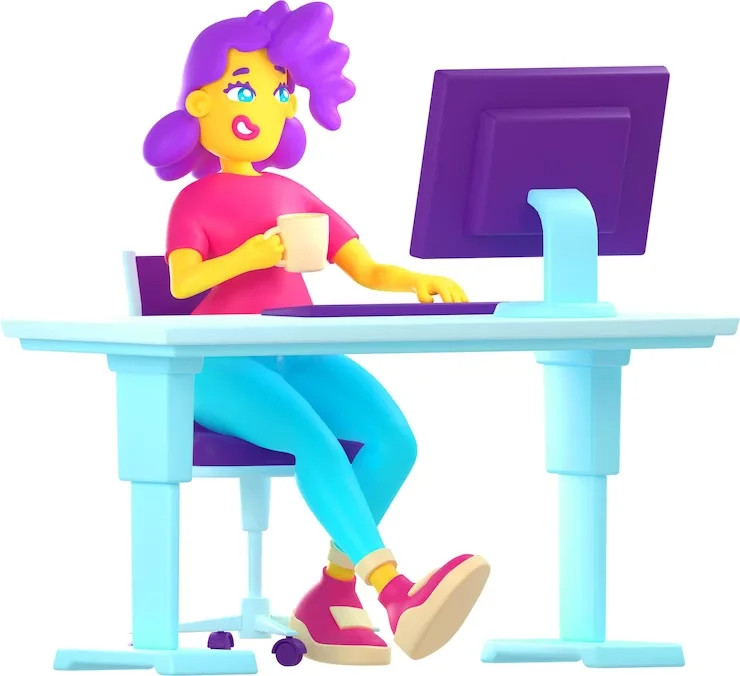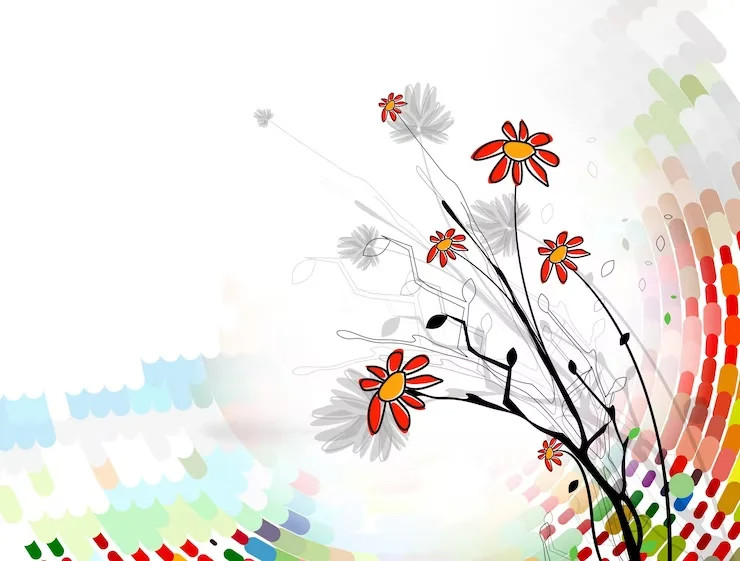A good design casts a positive impression on your target audience. Visuals of design are essential to engage your audience highly. Vector art is highly used in different design projects, e.g., graphic design, digital design, and illustrations. The best thing about vector art design is that once you’ve created a vector image, you can resize it and change its colors for your marketing assets and web design without compromising the quality.
As a graphic designer, you must learn vector art design. This blog has everything you need to know about vector art design, from basic principles to advanced techniques.
What Is Meant by Vector Art Design?
Vector art design is a type of graphic design that uses mathematical equations to create digital images. Unlike raster images, which are pixels, vector graphics are composed of paths and curves that can be resized, edited, and manipulated without losing quality or clarity.
This makes vector art ideal for logos, illustrations, and other designs that need to be scaled up or down without losing detail. Vector art can be created using software programs such as Adobe Illustrator or CorelDRAW, and it is commonly used in industries such as advertising, printing, and web design.

Why Is Vector Art Important in Modern Web Design?
There are several reasons why vector art is used a lot in modern web design. First, vector graphics are lightweight and have small file sizes, making them ideal for use on websites with critical load time.
Second, because vector graphics are independent of resolution, they can be scaled up or down without losing quality or becoming pixelated. This is important for creating responsive designs that adapt to different screen sizes.
Third, vector graphics are easily editable and manipulated, allowing designers to create unique and dynamic visual effects.
Lastly, vector art is often used to create logos and icons, essential elements in establishing a brand’s visual identity on the web. In simpler words, vector art is a versatile and valuable tool in modern web design that allows designers to create visually appealing, high-quality graphics that enhance the user experience and make an attractive UI.

How to Make Vector Art Yourself?
If you create your website or app icons or want to market your brand identity through visuals, you should learn how to create vector art. Many online courses and video tutorials can teach you how to create vector art design yourself. Creating vector art can be fun and rewarding for anyone with a creative streak. Here we have created a list of steps to help you learn how to create vector art yourself:
- Choose a software: Choose the software you are comfortable with or learn how to use it by watching tutorials, e.g., Adobe Illustrator or CorelDRAW.
- Choose an idea: Decide on the subject matter of your vector art, e.g., landscape or abstract.
- Sketch your idea: Create a rough sketch of your opinion on paper or digitally to have a blueprint for your vector art. Your idea should be presented in written form to visualize it better.
- Create a new document: Open a new record in your chosen software and set up the size, resolution, and color mode according to your requirements.
- Start drawing: Use the software’s drawing tools, such as the Pen tool, Shape tools, and Gradient color tools, to create your vector art. Start with the basic shapes and add details as you go along.
- Edit and refine: Use the software’s editing tools to refine your vector art. This includes resizing, reshaping, adjusting colors, and adding effects.
- Save and export: Save your vector art in a proper format, such as AI, EPS, or SVG, and export it as a PNG, JPEG, or PDF for further use.
With practice and experimentation, you can create beautiful and unique vector art that reflects your creativity and brand identity.

5 Best Tools for Vector Art Design
Whenever you hear anything related to graphic design, the first tools that come to a designer’s mind are Adobe Illustrator and Coreldraw. But not every designer can be comfortable with using these two. Luckily! Many tools are available now, making graphic design much simpler and more accessible. We have a list of the five best tools for vector art design that will also be easy for you to learn.
- Inkscape
- Sketch
- Adobe Capture
- DesignEvo
- Vecteezy
1) Inkscape
Inkscape is a free, open-source vector graphics editor that offers a wide range of tools and features for creating vector art. It has a user-friendly interface and supports various file formats, making it an ideal tool for beginners.
2) Sketch
Sketch is a professional vector graphics editor popular among designers for its ease of use and intuitive interface. It offers a wide range of tools for creating vector art, and its real-time collaboration feature makes it easy for teams to work together.
3) Adobe Capture
Adobe Capture is an excellent mobile app that lets you capture images and convert them into vector art using your smartphone camera. It also offers a range of tools for editing and refining your vector art.
4) DesignEvo
DesignEvo is an online logo maker offering various templates and tools for creating custom logos. It has a user-friendly interface that allows you to export your logos in various file formats.
5) Vecteezy
Vecteezy is an online platform that offers a range of vector graphics, including illustrations, icons, and patterns. It also has a vector graphics editor that allows you to customize and edit these graphics to suit your needs.

Uses of Vector Art in Different Industries
Vector art is a versatile and practical technique used in various industries to create high-quality digital artwork. Unlike traditional raster graphics, vector graphics can be scaled infinitely without losing quality or becoming pixelated. This makes them ideal for various applications, from designing logos and icons to creating animations and illustrations.

Graphic Design & Printing Industry
One of the most common uses of vector art is in the graphic design industry, where it is used to create everything from billboards and flyers to product packaging and branding materials. Because vector graphics are easily scalable, designers can create high-quality designs that can be reproduced in various sizes and formats without losing clarity or resolution. This is particularly useful in the printing industry, where vector art creates high-quality, large-format prints for billboards, banners, and other promotional materials.
Animation Industry
Vector art has a great hold in the animation industry as well. It is widely used to create 2D and 3D animations for films, television, and video games. It is so popular in the animation industry because it is ideal for creating animated characters and objects, as they can be manipulated and transformed easily. And it doesn’t lose the quality of animations in the process. These benefits make it easier to create complex and detailed animations that are also visually appealing and aesthetic.
Web Design
Another industry that makes extensive use of vector art is web design. Vector graphics are commonly used in web design to create icons, logos, and other graphics that can be easily scaled and optimized for different screen sizes and resolutions. This makes websites more visually appealing and user-friendly and helps to improve overall user experience.
Architecture and Other Industries
In addition to these industries, vector art is used in architecture, engineering, and scientific visualization. For example, architects use vector graphics to create detailed floor plans and elevations, while engineers use them to develop technical diagrams and schematics. Scientists and researchers use vector graphics to visualize complex data sets and create detailed scientific illustrations.
Must Learn about Accessibility Design at Scale.
How to Use Vector Art on Your Website?
Vector art design is a powerful tool for enhancing your website’s visual appeal while ensuring it is responsive to different screen sizes. Vector art is being used on websites for various purposes, from adding visual interest to enhancing functionality.
Create vector graphics appropriate for your website’s content, such as logos, icons, or illustrations. Be sure to consider your website’s color scheme and style when creating your vector art to ensure consistency and coherence.

Once you have created your vector art, save it in the appropriate format and upload it to your website. With vector graphics, you can be confident that your website will look great on any device and that your images will remain clear.
This will add a touch of style and design to your online presence. Moreover, vector art can be animated, which adds an extra layer of interactivity and engagement to your website. To sum it all up, vector art is a versatile and valuable tool for any website designer looking to enhance their website’s visual appeal and functionality.
Read about Empathy in UX Design.
Summary
Vector art is a powerful tool to enhance both your UI and UX. You must learn how to create an effective vector art design that appeals to your audience. As vector art images are not pixelated by recoloring or reshaping, they are easier to use in unique and dynamic visuals. As a rookie product designer, it is not very hard to learn how to design vector art images. There are tonnes of tools available on the web that can guide you through tutorials while creating a vector art design.
The uses of vector art design are varied and widespread, and the technique is essential for many professionals in different industries. With its versatility, scalability, and ability to maintain high quality at any size, vector art will remain a necessary part of the digital design landscape in the future. Start creating eye-catching graphics today!
FAQs
Which Software Should Be Used for Vector Art?
The top 5 best software for vector art design are:
Illustrator.
CorelDRAW.
Sketch.
Inkscape.
Adobe Capture.
Is Vector Art Design Made in 2D or 3D?
Vector art is designed through a mathematical equation on the computer along with lines, shapes, and points. They are usually designed in 2D, but some elements and textures can give the image the appearance of a 3D design.
